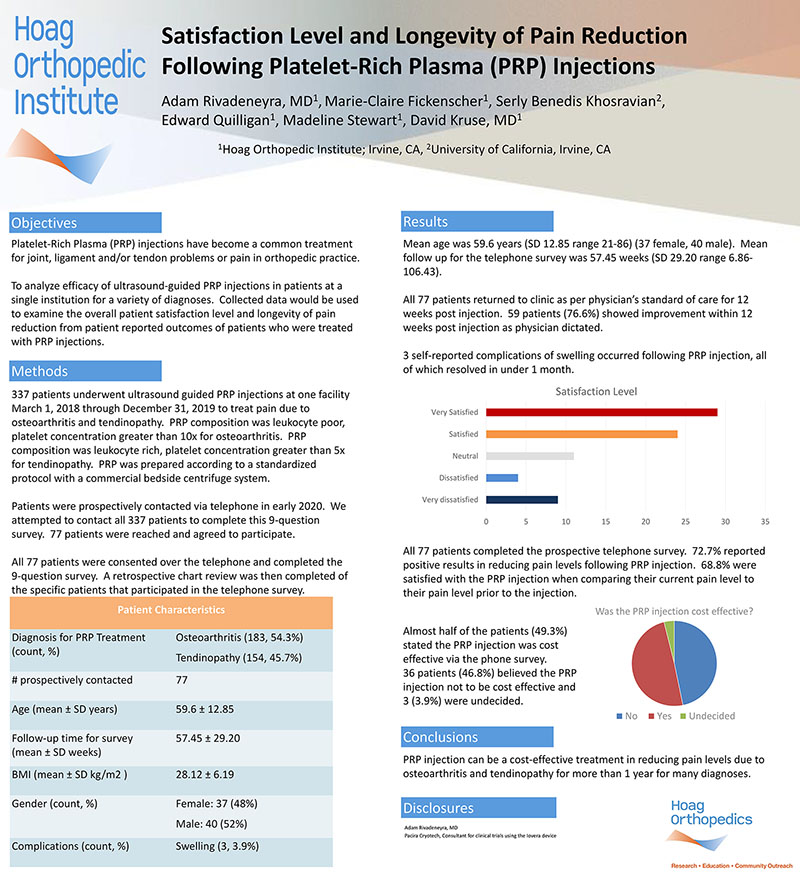
Hover to pan and click to magnify. Click again to pan at full screen.
Adam Rivadeneyra, MD, Marie-Claire Fickenscher, Serly Benedis Khosravian, Edward Quilligan, Madeline Stewart, David Kruse, MD
Adam Rivadeneyra, MD, Marie-Claire Fickenscher, Serly Benedis Khosravian, Edward Quilligan, Madeline Stewart, David Kruse, MD
Hoag Orthopedic Institute; Irvine, CA, University of California, Irvine, CA
Objectives
Platelet-Rich Plasma (PRP) injections have become a common treatment for joint, ligament and/or tendon problems or pain in orthopedic practice.
To analyze efficacy of ultrasound-guided PRP injections in patients at a single institution for a variety of diagnoses. Collected data would be used to examine the overall patient satisfaction level and longevity of pain reduction from patient reported outcomes of patients who were treated with PRP injections.
Methods
337 patients underwent ultrasound guided PRP injections at one facility March 1, 2018 through December 31, 2019 to treat pain due to osteoarthritis and tendinopathy. PRP composition was leukocyte poor, platelet concentration greater than 10x for osteoarthritis. PRP composition was leukocyte rich, platelet concentration greater than 5x for tendinopathy. PRP was prepared according to a standardized protocol with a commercial bedside centrifuge system. Patients were prospectively contacted via telephone in early 2020. We attempted to contact all 337 patients to complete this 9-question survey. 77 patients were reached and agreed to participate. All 77 patients were consented over the telephone and completed the 9-question survey. A retrospective chart review was then completed of the specific patients that participated in the telephone survey.
Results
Mean age was 59.6 years (SD 12.85 range 21-86) (37 female, 40 male). Mean follow up for the telephone survey was 57.45 weeks (SD 29.20 range 6.86-106.43). All 77 patients returned to clinic as per physician’s standard of care for 12 weeks post injection. 59 patients (76.6%) showed improvement within 12 weeks post injection as physician dictated. 3 self-reported complications of swelling occurred following PRP injection, all of which resolved in under 1 month.
All 77 patients completed the prospective telephone survey. 72.7% reported positive results in reducing pain levels following PRP injection. 68.8% were satisfied with the PRP injection when comparing their current pain level to their pain level prior to the injection.
Almost half of the patients (49.3%) stated the PRP injection was cost effective via the phone survey.
36 patients (46.8%) believed the PRP injection not to be cost effective and 3 (3.9%) were undecided.
Conclusions
PRP injection can be a cost-effective treatment in reducing pain levels due to osteoarthritis and tendinopathy for more than 1 year for many diagnoses.
Disclosures
Adam Rivadeneyra, MD
Pacira Cryotech, Consultant for clinical trials using the Iovera device
Present with Google Meet
Invite as many as 30 people, and present your poster in high definition. Transcription option is available. Free to use.
DISQUS COMMENTS WILL BE SHOWN ONLY WHEN YOUR SITE IS ONLINE